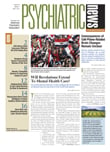The Department of Defense and the Department of Veterans Affairs have received enormous funding from Congress for treating PTSD, but we can't view that as a bottomless pit," Navy Capt. Paul Hammer, M.C., said at the first meeting of an Institute of Medicine (IOM) panel that will study the current status of research and treatment of posttraumatic stress disorder (PTSD).
"We have to learn to treat PTSD at a reasonable cost," said Hammer, an APA member and the new director of the Defense Centers of Excellence for Psychological Health and Traumatic Brain Injury.
Doing that requires knowing more about the disorder, its causes, diagnosis, and treatment, so the Department of Defense (DoD) requested the IOM study. The panel is chaired by Sandro Galea, M.D., Dr.P.H., a professor and chair of the Department of Epidemiology in the Mailman School of Public Health at Columbia University.
The request came three years after another report from the IOM noting that "significant gaps" existed in the evidence underlying nearly all treatments for PTSD (Psychiatric News, December 7, 2007). The earlier report said that only therapies that included some element of exposure to reminders of trauma—like prolonged exposure therapy, cognitive-behavioral therapy, or cognitive-processing therapy—were backed by sufficient evidence from clinical trials.
"The 2007 PTSD report was simply an evaluation of the evidence on best practices for PTSD," said Galea. "Our mandate with this study is to understand what the best approach to screening, prevention, treatment, and rehabilitation for PTSD is and what DoD and the Department of Veterans Affairs [VA] should be doing about it."
The panel will spend two years gathering information from the two federal departments "on programs and methods available for the prevention, screening, diagnosis, treatment, and rehabilitation of posttraumatic stress disorder," as well as study clinical trials of innovative treatments and services. The panel will then take another two years to evaluate the rates of success of each modality.
The study could clarify how well current PTSD programs are working and identify gaps in assessment and treatment, said Hammer during the panel's initial meeting in late February.
About 2.4 percent of the 2.2 million deployed service members have been diagnosed with PTSD, but depending on survey methodology, 10 percent to 17 percent of service members report some symptoms of PTSD, he noted.
Several areas require special attention in any study of PTSD in military populations, Hammer pointed out.
For example, "patterns of comorbidities are different in military populations, compared to the civilian sector," he said. Mild traumatic brain injury, pain, and substance abuse are common. In addition, combat troops less often report Category A ("horror") PTSD symptoms, because their military training and experience prepares them for battle. But they also have less access to protective factors due to their frequent re-exposure and the "tough-it-out" military culture, he said.
National Guard and Reserve personnel are at even greater risk of PTSD and have less access to therapists skilled in PTSD care for military populations because they are dispersed geographically after they return from war zones.
The armed forces have used several strategies to protect troops. Education and training begin at the start of military service. Increased screening and surveillance, interventions to manage combat stress in the field, and a full spectrum of available treatments in war zones and at home also serve as factors that may mitigate the likelihood or severity of PTSD.
The Military Health System has increased behavioral health staffing from about 4,000 in 2007 to about 6,500 now, so fewer referrals for care go unfulfilled.
Spending on PTSD care for the current cohort of veterans is likely to be high, and the true costs of treating them needed to be made clear, said Hammer. But more work needs to be done first.
"Data are problematic on the effectiveness of current therapies," said Hammer. "We don't know what type of therapy is used or whether the therapist has made individual modifications. We don't have the ability to track measures over time."
The executive director of the VA's National Center for PTSD (NCPTSD), Matthew Friedman, M.D., Ph.D., stressed that more should be done to monitor outcomes in clinical practice, expand the use of evidence-based therapies and clinical practice guidelines, and increase quality improvement and program evaluation efforts.
The National Center for PTSD is a hub for research into the neuroscience of PTSD and its treatment, along with ways to move that research into the clinic. Basic research there now addresses mechanisms underlying the development of PTSD, as well as resilience, treatment effectiveness, and treatment resistance, Friedman told the IOM panel.
The NCPTSD also provides PTSD-related assessment tools, training, treatment guides, and consultation services within the VA, he said. In addition, it provides information on PTSD and its treatment for outside clinicians and for the public via its Web site.
The IOM study, when completed, will help guide future DoD and VA policies for screening, diagnosing, and treating service members and veterans. That can't come too soon, said Hammer.
"We need to get it right and target well for what works," said Hammer.
